Welcome to the very first Diverse City column on DC Theater Arts. My name is Darby DeJarnette and I created this column to highlight, through interviews, the different experiences of individuals from various social and cultural backgrounds who work in theater and the arts in the DC metro area. These individuals are integral members of our theater community in Washington D.C. and we are so glad that we have them in our community.
The creation of this column was very personal to me. There have been times in my life where I’ve felt unable to express myself because I thought no one would understand my experiences. My goal in sharing these interviews is to help uplift other marginalized individuals, and individuals who work within marginalized communities, so that they have another outlet from which to speak their truth. To share their stories shows us how much we have in common, but also helps us to appreciate and understand our differences. I hope that others may find something within the narratives of these amazing individuals that they can relate to. No one should have to feel silenced or alone.
On to the interview…
Elena Velasco is a super woman. There’s just no way around that. I was already impressed by her extensive resume before we met. She is currently the Artistic Director of Convergence Theater, which is producing This is All Just Temporary to be featured in the 2018 Women’s Voices Theater Festival. She is a Co-creator and Resident Artist at Imagination Stage’s Óyeme project, which works with children who have come here as refugees fleeing violence in Central America. Elena is also the Co-Director of Diversity and Multiculturalism at the American Alliance for Theatre and Education and an Assistant Professor of Theatre Arts at Bowie State University.

Having not gotten any sleep the night before, I found my over-caffeinated self navigating the dizzying underground maze that is Crystal City to interview Elena about some of her current projects. It would be impossible to cover everything in her background and I was nervous about talking to her, but she has a way of directing a conversation with an authority that is gentle, yet self-assured. My concerns were easily set aside as, seated in Synetic Theatre’s studio space, we began our interview…
What does DC being a “Diverse City” mean to you?
I think that we are seeking to open ourselves up to many different voices, and particularly those that have been marginalized, and now are taking responsibility for listening to those voices, what their lives, their life experiences, and their needs are. That sounds very overly simplistic, but I think the upside of what happened 13 months ago (Note: She is referring to the 2016 presidential election) is that it has prompted many to recognize their privilege and recognize it as an opportunity to bring forward issues that affect those who do not have that privilege and who are being targeted. This may sound very divisive, I know— and it’s not because, really, ultimately, our goal should be to invite discourse from many different opinions. Diversity means that too…and I recognize that.
Somehow we need to coexist and to show respect for one another while retaining our own individual identities. Some of those identities are grounded in a culture, family history, economics and some of them are gender-based, but that’s what I think is the ideal of the diverse community that DC can be. Seeing where we are we’ve certainly grown over the past 20 years, not only as far as the richness of theater, but also the presence of different diverse groups and becoming more aware of the need to accept different diverse voices. That said, we have a long way to go.
Yeah, I would definitely agree with you on that point.
Again it goes back to privilege —“becoming aware” is more than an individual responsibility. Visibility is part of the equation.
Moving on to your personal story… How did you first get involved in theater? How was your passion for theater first ignited? What made you think, “this is what I want to do with my life”?
I began doing some theater in secondary school and such and I’ve enjoyed that as a very social activity. I found that I was very passionate about it. I think once you find that passion, that’s kind of it. Your path is predetermined. What really struck me is going from my initial passion of wanting to be a performer, then having my eyes open up and seeing what the power of theater can do to transform lives. I moved away from being performer-based and explored theater more as a director and all the different ways to shape story and then expanding from that. What does it mean to be a theater artist? That there are so many different performance languages that are out there that we can shape.
I went from performer to a director, to choreographer, then to doing some sound design and really looking at how wonderful this collaborative art is. The fact that it is multi-disciplinary allows for many different forms communication to come out, which means that it invites diverse audiences and diverse opinions, but also it provides access. That’s the other thing too, that really strikes me. For example, I work with Synetic Theater, an amazing physical theater company in Arlington. Synetic Theater is not necessarily a “social justice” mission theater. I’ve worked with them since they were Classica back in 2000, one of the reasons I stayed along for so long, is the great respect I have for Paata (Note: Synetic Theatre’s Artistic Director), I think he has developed an amazing codified performance language that provides access to people in a way that, say, verbal text does not. It’s limited. The word is limited, but when we start talking about a visual language and a kinesthetic language now, all of a sudden, we have different people who can reach that story.
One of things I had done for them back before we were in this space, when we were in Shirlington, was that I directed a lot of family theater. We just had the relaunch of the family theater with Hansel and Gretel, which is exciting because that’s what we did in Shirlington, but making theater that was nonverbal, finding that children of all different children language backgrounds and children of different educational backgrounds or educational needs, or who are differently abled were able to access the story. It was wonderful and then they sometimes feel empowered enough to go, “no, this is what I see,” and it was totally legitimate because of the fact that the story is not limited to what is on the paper. It is completely, entirely filtered through the perspective that you have. Your story that you receive out of there is unique— and it should be. That’s really what brought me into it deeper, I think, the understanding that theater empowers because we all have a story and we connect our story to somebody else.
Talking about the sort of visual performance…how even the visual part may be more able to connect to different types of people then the language itself, especially when you have a language barrier, that’s really interesting. Not something I’ve thought about often.
How has your identity and personal experience informed the way you approach the theater community and industry?
Its evolved over time. I know, early on in my career, particularly because I started having a family very young, I made
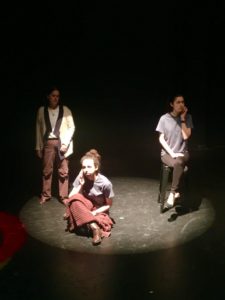
choices that were family friendly and so that initially shaped the way that I approach art— making sure it was something that was accessible to a diverse age group. Thinking about how story was shaped and perceived through a child’s eyes, but as well as the parent. How could I have that conversation fostered? Recognizing, too, that there is unequal access to theater for different areas because of economics and geography. Making sure that the access was provided was important to me.
That kind of just opened up as I got older. I continue to do work with youth, particularly within my own community—the Latino community— how much theater is provided and is visible to the greater community that’s out there. It’s not that it doesn’t exist; it does. Again, it’s about stories being told and I think particularly now— recognizing the crisis in the Northern Triangle and the influx of undocumented youth trying to escape gang violence—this is a community that desperately needs their story to be shared. The personal stories of their journeys, which are incredibly impactful, recognizing the beauty of the culture and their resilience. So, those are the things that are really helping shape my choices that I want to put out there.
Convergence Theatre is described as “a performance collective focused on evolving theatrical language to invite discourse on issues of social justice.” How does the theater connect with and stay involved in local activism and social justice movements?
Part of it is community partnerships. What we have found, and we’re still a fairly young company, is that by taking the performance element and finding ways for it to connect immediately to different organizations— ideally, non-theater organizations— people are able to see how this particular mode of communication can be a resource and a tool for them to share stories, but also for them to explore conversation on how to build those conversations and coalitions. For example, our production of Witch, a production we did at the Mead Theatre Lab—
Yeah, I saw the pictures. It looked great.

Thank you. It was a fusion of 17th century text and accounts from domestic violence and sex trafficking victims. The conversations that we wanted to have come out of that: How do we identify those who are victims in our community? How do we connect them with those who have resources to assist? How do we change the environment to invite individuals who need support? Just so many questions that surrounded this issue.
Well, we built “conversations” that would happen afterwards. We’ve now formed that into this model we call “Converging Minds.” It’s not really a post-show discussion about the play. That’s great, but that discussion was a conduit to get to here. Some of the organizations that came to speak with us we developed partnerships with afterwards. The Domestic Violence Resource Project is a good example. We had built a forum theatre event that came out of that production. Through our partnership with them we had a community gathering for their own organization, which was social workers and clients and family members, with everybody understanding how you use theater: Not only to revisit and reexamine, but perhaps to determine, “How do I shape other paths? How do I get out of the situations that I’m in? Who are the people that I can turn to?” Even feeling as though they even have places to turn. That’s a really great example of how we’re trying to stay involved with the community.
Our current production of This is All Just Temporary centers around a family that has to provide lifelong care for an autistic family member. Annette Mooney Wasnow, our Connectivity Director, has built all of these different post-show activities through Converging Minds connecting the resources out there whether it’s Art Enables, or Walk One Day In Our Shoes, The Arc of Northern Virginia– all these different partners out there who are providing resources to families and making sure that people know that they are there. That’s the coalition-building part. Sometimes you don’t know the resources that are there. How do you get support? How do you know how to assist and how can you be part of that community that’s moving the conversation forward?
Something that I saw on your website that looked really interesting was the Activist Art Festival. What do you hope to contribute to the theater community with initiatives like that?
Really, it’s providing a place to test those evolutionary works that are addressing issues of social justice. For new writers and new artists it’s really just providing that venue and space to be able to be heard. Also, to engage in issues that are controversial, but at the same time explore how you would invite dialogue to something that is otherwise controversial. That’s really the aim of the Activist Art Festival. We all have something that we’re really passionate about regardless of where we are on the spectrum of our politics or our personal lives. How do we take that—how do we passionately use our voice, and maybe even in a way that seems as though it has a single direction, but then help those artists a space to open that direction up in a way that invites conversation?
I’m not sure if we’ll get to that this year just because we’re working on New Nation during the same time slot that we had the Activist Artist Festival, but it is definitely something that I want to go back to revisit. I think it’s really important for us to find a space for those voices that are newer to the theater or social justice realm and being able to explore how to craft conversation. That’s the hardest part. Crafting dialogue is so, so hard in way that is not directional. It’s not telling us that this is the mindset that one needs to have, but rather, how do I invite someone else to talk to me that has a completely different perspective?
Can you tell us a little bit about your work with Óyeme?
Óyeme was a project that began four years ago at Imagination Stage. I have a long history with Imagination Stage between being an actor there in the 90s and then working on Imagination Quest, which is an outreach program. I met with Janet Stanford when I went back to grad school. I noted the huge crisis in Montgomery County with this influx of children who are coming into schools. Some of them don’t necessarily have families, or are seeking families here, but they’re undocumented and teachers are just kind of at a loss of what to do. These are children who have experienced extreme trauma and then, meanwhile, there are just daily things that they are individually fighting, not the least of which is just finding refuge and amnesty to be here. We said, “we feel like theater can do something.”
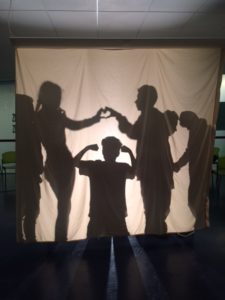
We all came together to build this program that’s basically a theater haven for unaccompanied minors. Primarily we’re providing the program for students who are in secondary school. The age of those who are coming here unaccompanied ranges, from the teens to age eight and some are even younger. We’re just recognizing that, number one, you have to provide a community. This kind of goes back to the beginning of our conversation. Community is so, so, so important. It’s important for them to find a place where they can bond with others— and we’re using theater as a way that they can do that.
It began very simply in the first year. We said, we’re just going to build a place where they can come and we’re going to introduce them to different theater games and different arts outlets: sometimes it was mask making, sometimes it was doing shadow play with film, and from there starting to invite their stories so that they could work with professional playwright Miriam Gonzales, who is one of our co-founders as well. Always putting the stipulation out there that anything they don’t want to share, they didn’t have to share and obviously that their identity is always protected. There are many things that they’re putting at risk, so we don’t share their identity. The importance of sharing their story and what they’ve gone through to get here was immensely important to us. Then taking that piece and refining it and turning it into a touring piece that can go to community centers, colleges, and places where— reaching some of the population that doesn’t know about their situation, but also reaching the populations that do know so they can say, “Thank God somebody knows my story.”
So that’s really what Óyeme started as and what it continues to be. Sort of the trajectory that we’re hoping for is that we can continue to create works with the students after school and in these in-school residencies so that they can feel empowered to shape it in to many performances with their own community as well.
That’s great. That’s so amazing. Honestly.
Well, we’re connecting them to resources too. One of the things we did in the second semester was “lawyer up.” Everybody, who has a lawyer and who does not have a lawyer? Recognizing that we were in the rocket docket phase where they were just putting kids through the system really fast and putting them through hearings without having any substantial legal representation and just getting them sent back.
Ugh.
Right? So we said, “Who doesn’t have a lawyer?” We partnered with Kids in Need of Defense to connect them to services.
That’s amazing. Moving on to a different topic: How did you get involved with the Women’s Voices Festival? I know you talked a little bit about This is All Just Temporary, but what can audiences expect from this show?
Sometimes you feel like your sacrifice for your family isn’t enough and yet, you have to remember that sometimes the simplest things you can give to your family can make the greatest impact. I think that’s one of the things that our main character learns. Her brother, who is the family member with autism is never seen on stage and that was very strategic on our playwright’s part. This is, in many ways, her story. This playwright— this was her experience. She has a brother who is 24 and he requires lifelong care. She said, “I’ll never be David. I’m not going to know his story or his experiences, so I’m not going to try to do that, but I know mine and I know the things that my family has had to go through and I know things that other families had to go through.”
Wrestling with the understanding that there’s so much that you want to do and you have to wrestle with what you can do and also recognizing, at the same time, that we need to also hold others and the resources that are out there to some level of accountability. We hope that people know that there are people who are not being served. This is a population that is greatly underserved and particularly, where they were living in Virginia, the resources for adults who are differently abled are quite poor in many ways. You age out of the resources that are available. You don’t age out of that condition. So, being able to say that “I’m going to give everything I can, but I’m also going to be your advocate for life.” I think those are the two things we walk away with. How do we all recognize that we can be an advocate for somebody in our community? In many ways that’s what we need to do. We don’t survive by ourselves, we survive because we have a network, whether it’s the family we have or the family we build. It’s alright.
I have one last question for you, can you sum up the legacy that you’d like to leave to the theater community, like, if you could say, “This is what I want to be remembered for…”?
I want to be remembered for bringing theater outside of the theater, for carrying it into our everyday lives, so we remember that “theater is a rehearsal for the revolution.” That is not my quote, that is Baol’s quote. (Note: She is referring to Augusto Boal’s Theatre of the Oppressed). I want to live that quote. We take this as a moment to rehearse what we want to see change and then put that change in the world and make good on the world that we see.
That’s fantastic. So, I wanted to try something a little bit different…To show how— despite the fact that we are from different backgrounds— we are all connected, can you give me a question that you would like me to pose, from you, to the next person I interview?
That’s a great idea…so, how do you plan to mobilize your audiences to make change in our community?
That’s a great question! Thank you very much.
You are quite welcome.
—
This is All Just Temporary is playing from January 19, 2018 through February 10, 2018 at Convergence Theatre— Anacostia Arts Center, 1231 Good Hope Road Southeast, Washington, DC 20020. This production is part of the Women’s Voices Theater Festival. Tickets can be purchased online.


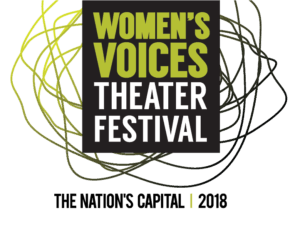

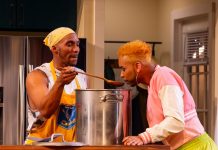
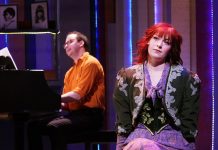
Elena Velasco is an amazing talent and a remarkable woman. My daughter had the good fortune to work with her on a Synetic youth production and learned so much from her. Thank you for this fascinating interview.